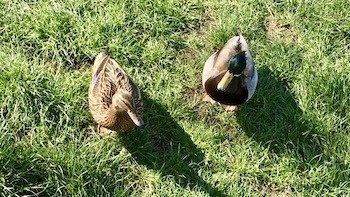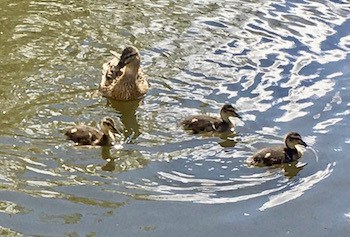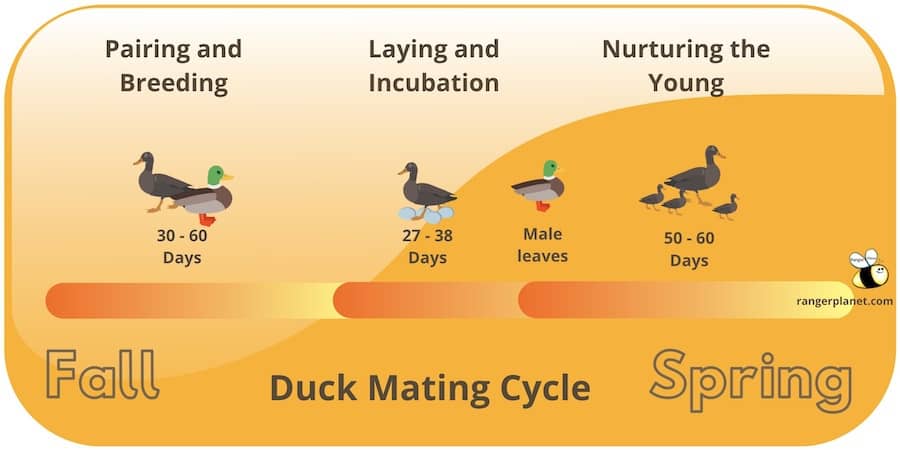Ducks are those wonderful local birds that you often see in pairs around the river bank. When in pairs they can seem like a real couple for life. But is that the case? And in the case of Mallard ducks, do Mallard ducks mate for life?
This subject certainly has its twists and turns, so let’s start with a summary to give you a quick summary.
Mallard ducks do not mate for life – known as forming long-term pair bonds. They commit to the female during the mating season, known as a seasonal bond. This occurs between fall and spring. Males leave after the female lays eggs, and the female alone takes care of the young.
Of the many facets that animals possess, one thing that many wonder about is whether true love or a mate for life exists in the animal kingdom.
There are some, but among many of the animals that have been put into this potential area, one such animal – or more specifically a bird – revolves around mallard ducks.
A mallard male duck abandons the female during incubation
Mallard ducks do not mate for life – rather they mate and remain together only until the female lays her eggs.
At this point, the male mallard duck abandons the female leaving her to incubate the eggs on her own. The male leaves the female and searches for a secluded and food-rich spot.
Once finding his ideal place, the male mallard will then relax through the period in which he undergoes his seasonal molt.
The female duck incubation period
The incubation period for a female duck lasts for around 27 to 38 days.
During this period the female will build a nest by the water using her breast feathers and twigs – alone. When the ducklings hatch they are taken to the water relatively quickly – for safety purposes.
The ducklings remain with and follow their mother for about 50 to 60 days. They stay with their mothers until they develop their ability to fly.
Other than these the ducklings are precocial. This means that these tiny ducklings know how to swim and feed just after they are born.
All caring for offspring is done by the female duck alone and the father or the male mallard duck has no involvement.
Mallard ducks do not mate for life
Mallard ducks do not mate for life. Indicated by the fact that they only remain together until the female lays her eggs. Mallard ducks will then find a place to begin a period of molting. They do not form an everlasting love or mating for life with the female.
After a mating season with a pair, the ducks do not stay together or come together for the next season. In fact, they may never meet again at all. They change their mating pairs prior to every mating season.
Both the male and the female will likely find a new pair during the next fall.
In fact, hybrid breeds among mallard ducks are so common now that they are giving rise to the American black duck and northern pintail.
So the obvious question now is, what makes many of us think mallard ducks mate for life.
Mallard ducks are deeply affectionate towards their mate
The reason why many believe that mallard ducks mate for life is how they appear to remain affectionate, connected, and committed to their female during the period they stay together (mating season).
This connection the pair has during the time they remain together or the mating season makes it quite hard to believe that they aren’t soul mates for life!
The devotion of the mallard duck
A male mallard duck is even unlikely to leave the side of a dead female duck. And have been known to remain by the side of the female duck even when there are potential dangers nearby.
This behavior could be interpreted simply as the male duck instinctively caring for his investment in the breeding process.
But many experts believe that the ducks stay committed to the pair during the nesting breeding or mating season as support for the female.
Real world example
Domestic ducks may behave differently, because food is almost always available, and the ducks are reared and not always left to their own devices.
In the wild we see the true nature of what happens. This is what I saw when I tracked progress on a pair of mating Mallard ducks.
The pictured below show the ducks that regularly visited me, I suspect mostly because I brought food!

Pairing and Breeding
I watched the progress of a pair of breeding ducks and saw as the male always allowed the female to feed first before he then takes food.
The male duck was also constantly wary of their surroundings, waiting to chase off would-be interlopers or moments where they should escape threats. And he would follow his mate around wherever she chose to go.
Laying and incubation
This mating period continued for some 5 or 6 weeks. Then for some time, I saw the mallard duck alone – with no female in sight.

Nurturing
The next day, I spotted the female with 3 ducklings. She even swam toward me as if to “show” me her new brood. It seemed the mating season for them was complete – and I was glad to have seen the whole process unfold.
Both the male and the female still visit, but I’ve even noticed that the Drake will now chase the female and her ducklings away in order to keep any food for himself. Nature can be harsh.
So, all these expressions of seemingly true love do not negate the fact that mallard ducks are, after all, animals, that come together to fulfill an instinctive purpose.
As romantic and endearing as this side appears to be from mallard ducks, there are pretty unruly mating patterns that clearly show mallard ducks are polygamous.
Mallard ducks and their mating patterns
Pairing up with a female mallard duck is not that easy!
The females have high standards, and so it almost takes a lot for male mallard ducks to win a pairing.
The male mallard duck is expected to have the most colorful plumage, along with beautiful mating calls and rituals.
This means that in order for a male mallard duck to pair up with a female, he needs to have beauty along with singing and dancing skills.
And unfortunately, males often don’t measure up with the female’s expectations.
So this makes mallard ducks engage in socially organized gang rapes that are violent, aggressive, and harsh.
This gang sometimes leaves the female dead. Such is the mating patterns of mallard ducks and it certainly does not give the impression of a mate for life.
Specially developed reproductive organs
Males have to develop their reproductive organs in a way that would allow them to force their way into an unwilling female mallard duck’s reproductive organ.
And by contrast, the females have also evolved their reproductive organs more as a counter-defense measure against these rapes.
Females have developed sharp turns in their reproductive organs. This acts like teeth that make it difficult for a male mallard to inseminate during forced or unwilling copulations.
This helps the female ducks in naturally preventing the male ducks from fertilizing their eggs by force.
These gang rapes by mallard male ducks are sadly among different species of birds and not just the mallard females.
Depending on their selection by female ducks, the mallard ducks may stay affectionate, loyal, and committed to their pair only during the mating season.
And when failing to find or attract a female duck, they will not hesitate into forceful copulation even with other species of birds.
Let’s fill in some of the other possible gaps in your duck mating and duck parenting behavior knowledge by answering some further related mallard duck mating and caring questions.
Here’s an image that summarizes the timeline and progress of the duck mating cycle.

What is a female mallard duck called
The Mallard species of duck applies to both the male and female. The male is typically also called a Drake, and the female is referred to as a Hen, or simply known as a Duck. They are often also called Wild ducks.
How many ducklings are in a brood
Typically, female mallard ducks have up to 12 ducklings in a single brood. Numbers are higher to account for losses due to natural causes and predation. Often, at least 2 will survive until of fledging age. Fledging occurs once the ducklings can fly. They will then leave.
Do male ducks stay with ducklings?
Once the female begins incubation, or shortly after the ducklings hatch, most male ducks abandon the female to find a location for his seasonal molt. Male ducks play almost no role in caring for the brood.
bandon might seem like a strong term, but they do literally just leave, no warning or farewells. So it seems like abandon is the right term to use.
But this doesn’t mean the female is ill prepared for the scenario. They know and expect that this will happen and are well equiped to deal with it. It’s just natural.
How long do baby mallards stay with their mother?
Baby mallard ducks, at this stage called ducklings, will remain with their mother for up to 60 days, or two months. The defining point of leaving is when they full develop the ability to fly. At that point, they are no longer baby mallards, they are adult ducks.
How long do duck families stay together?
Ducks remain a complete family very briefly. Usually, once the ducklings hatch the male will depart, often they will leave before hatching begins. So the period of being a complete duck family is brief, possibly just a few hours if not minutes.
To finish…
I hope this has helped answer the question do mallard ducks mate for life. We’re all about nature here, so be sure to check out other articles. About ducks eating fish, as well as other nature-related topics.
